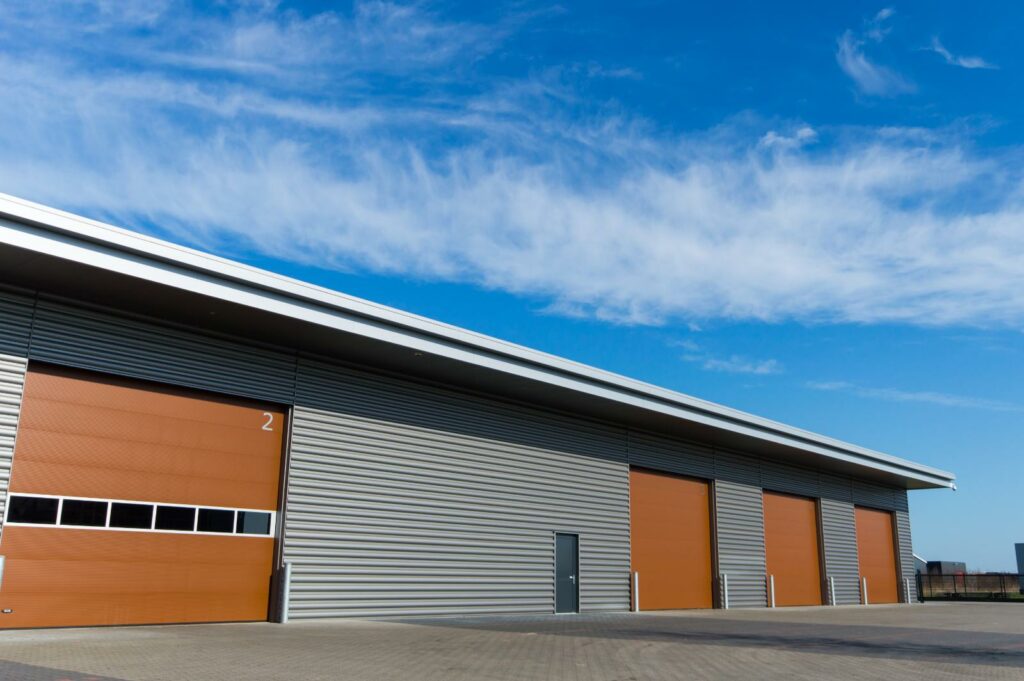
Contents
You might be surprised to learn that metal buildings, often associated with industrial aesthetics, are actually at the forefront of energy efficiency and durability in construction. From cutting-edge insulation materials to innovative ventilation systems, these structures have a lot to offer. But what specific features set them apart and make them stand out regarding sustainability and longevity? Let’s explore the key elements that make metal buildings a smart choice for environmentally conscious and quality-seeking individuals.
Key Takeaways
- Insulated metal panels with high R-value and cool roofing systems for energy efficiency.
- Corrosion-resistant coatings and recyclable materials enhance durability.
- Proper insulation reduces heat transfer and energy costs.
- LED lighting, natural light integration, and ventilation systems improve energy efficiency.
- Sustainable practices like recyclable materials and prefabricated components support eco-friendly design.
Insulated Metal Panels
When selecting insulated metal panels for your building, consider their R-value and thickness to ensure peak energy efficiency. The construction of insulated metal panels involves two metal sheets bonded to a core material such as polyurethane foam or polystyrene. This panel construction provides excellent thermal insulation properties, reducing heat transfer and minimizing energy loss.
The key advantage of using insulated metal panels lies in the significant energy savings they offer. The high R-value of these panels ensures better insulation, leading to reduced heating and cooling costs for your building. By minimizing thermal bridging and air leakage, insulated metal panels contribute to maintaining a consistent indoor temperature, enhancing occupant comfort, and decreasing the reliance on HVAC systems.
When comparing different insulated metal panels, pay attention to their thickness as it directly impacts their thermal performance. Thicker panels generally offer higher R-values, providing better insulation against heat transfer. Additionally, thicker panels can enhance the structural integrity of the building envelope, improving its durability and longevity.
Cool Roofing Systems
How do cool roofing systems contribute to energy efficiency and sustainability in buildings?
Cool roofing systems are designed to reflect sunlight and absorb less heat than traditional roofs, making them a key component in reducing energy consumption and maintaining comfortable indoor temperatures. The use of reflective surfaces in cool roofs helps to minimize heat gain, lowering the need for air conditioning and reducing cooling costs. By reducing the heat absorbed by the building, cool roofs also contribute to lower urban temperatures, mitigating the heat island effect in densely populated areas.
Cool roofs provide additional benefits when considering insulation options.
The reflective properties of cool roofs work hand in hand with insulation materials to enhance the overall energy efficiency of a building. Proper insulation helps regulate indoor temperatures by minimizing heat transfer, resulting in reduced energy usage for both heating and cooling. This synergy between reflective surfaces and insulation options not only improves energy efficiency but also extends the lifespan of the roof by reducing thermal stress.
Incorporating cool roofing systems into metal buildings offers a sustainable solution that benefits both the environment and building owners.
Energy-Efficient Lighting Options
When considering energy-efficient lighting options for metal buildings, you should focus on the benefits of LED lighting, the integration of natural light, and the efficiency of motion sensors.
LED lighting offers increased energy savings and longevity compared to traditional lighting systems. Incorporating natural light sources can reduce the need for artificial lighting during daylight hours, further enhancing energy efficiency.
Motion sensors provide a practical solution to make sure lights are only in use when needed, optimizing energy consumption.
LED Lighting Benefits
LED lighting provides a highly energy-efficient option for illuminating metal buildings. By utilizing LEDs, you can achieve significant cost savings due to their low energy consumption and long lifespan.
Compared to traditional lighting sources, LEDs require less maintenance and have a lower environmental impact, contributing to a more sustainable building design. The advanced technology in LED lighting allows for precise control over light output and distribution, enhancing the overall illumination of the metal structure while reducing energy waste.
Incorporating LEDs into your metal building not only guarantees energy efficiency but also promotes a greener environment by reducing carbon emissions. Embracing LED lighting solutions aligns with the modern push towards sustainable practices in construction, making it a fitting choice for your metal building’s lighting needs.
Natural Light Integration
Integrating natural light into your metal building’s design offers a sustainable and energy-efficient lighting solution. By incorporating daylight harvesting techniques and strategic skylight installations, you can greatly reduce the need for artificial lighting during the day. This not only lowers energy consumption but also creates a more comfortable and inviting indoor environment.
| Benefits of Natural Light Integration |
|---|
| – Reduced energy costs |
| – Increased occupant productivity |
| – Enhanced well-being |
| – Sustainable lighting solution |
Harnessing natural light through skylights and daylight harvesting systems can improve the overall efficiency and sustainability of your metal building, providing a well-lit space that promotes both environmental responsibility and occupant satisfaction.
Motion Sensor Efficiency
Motion sensor technology plays a key role in enhancing energy efficiency in metal buildings by automatically adjusting lighting levels based on occupancy, contributing to cost savings and sustainability.
Proper sensor placement is essential for maximizing efficiency. Sensors should be strategically located in areas where motion is most likely to occur, such as entryways, hallways, and work areas. This guarantees that lights only activate when needed, reducing unnecessary power consumption.
Thermal Break Technology
Thermal break technology in metal buildings plays an essential role in enhancing energy efficiency.
Providing insulation prevents heat transfer, helping to maintain a comfortable indoor temperature.
This technology is a key factor in optimizing the overall performance and sustainability of metal structures.
Insulation for Efficiency
Utilizing advanced insulation materials with thermal break technology greatly enhances the energy efficiency of metal buildings. By incorporating insulation with a high R-value and thermal break technology, these buildings can effectively minimize heat transfer through walls and roofs.
A key component in this process is the installation of reflective roofing, which helps to reduce heat absorption and lower cooling costs. Additionally, airtight seals play an essential role in preventing air leakage and maintaining a consistent indoor temperature.
This meticulous approach to insulation promises that metal buildings remain energy-efficient by reducing heat loss in the winter and heat gain in the summer. Overall, the combination of thermal break technology and proper insulation techniques is vital for maximizing energy efficiency in metal structures.
Prevents Heat Transfer
To enhance energy efficiency in metal buildings, the implementation of thermal break technology effectively prevents heat transfer through walls and roofs. Thermal bridging, which occurs when a conductive material creates a path for heat to flow through, can greatly reduce the overall energy efficiency of a building.
By incorporating thermal breaks in metal structures, you can interrupt this thermal bridging, thereby minimizing heat loss or gain. This technology acts as a barrier that limits the conduction of heat, helping to maintain a stable indoor temperature and reducing the workload on heating and cooling systems.
Additionally, using proper window treatments like insulated shades or films can further enhance the building’s energy efficiency by reducing heat transfer through windows.
Corrosion-Resistant Coatings
Applying advanced corrosion-resistant coatings to metal buildings enhances their longevity and durability in harsh environments. These coatings play a crucial role in protecting the structural integrity of metal buildings by preventing rust formation and corrosion, ultimately extending the lifespan of the structure. By creating a barrier between the metal surface and external elements, such as moisture and chemicals, corrosion-resistant coatings effectively shield the building from potential damage.
Rust prevention is a key benefit of these coatings, as rust can weaken metal structures over time, leading to structural issues and the need for premature repairs. The longevity of metal buildings is greatly improved when corrosion is kept at bay through the application of high-quality coatings. Additionally, the weather resistance provided by these coatings ensures that the building can withstand various environmental conditions, contributing to its sustainability and long-term performance.
Investing in corrosion-resistant coatings for metal buildings is a cost-effective way to protect your structure and reduce maintenance expenses. By choosing coatings specifically designed for the challenges posed by different environments, you can ensure that your metal building remains strong and durable for years to come. The application of these coatings not only enhances the aesthetics of the building but also reinforces its resilience against corrosion, making it a wise choice for long-lasting and sustainable construction.
Recyclable Building Materials
Recyclable building materials offer a sustainable solution for constructing environmentally friendly structures, promoting resource conservation, and reducing waste. Incorporating these materials into the construction of metal buildings aligns with eco-friendly design principles and contributes to sustainable construction practices.
By utilizing recyclable materials such as steel, aluminum, and copper in the fabrication of metal buildings, you’re actively participating in the promotion of eco-friendly design. These materials can be repurposed and reused, reducing the need for virgin resources and minimizing the environmental impact of construction projects. Steel, for example, is one of the most commonly recycled materials in the world, making it a prime choice for sustainable construction.
Opting for recyclable building materials not only benefits the environment but also supports the concept of sustainable construction. Sustainable construction aims to minimize the negative effects of building activities on the environment while creating healthy, energy-efficient structures. By choosing recyclable materials for your metal building project, you’re contributing to the longevity and resilience of the structure while reducing its carbon footprint.
Solar Panel Integration
When considering the installation of solar panels on your metal building, harnessing renewable energy sources becomes a key aspect of enhancing sustainability and energy efficiency. Solar panel efficiency is important in maximizing the energy output of your system. Integrated technology allows for seamless operation and monitoring of your solar panels, ensuring peak performance.
Modern solar panels are designed to be highly efficient, converting sunlight into electricity at impressive rates. By integrating these advanced panels onto your metal building, you can greatly reduce your reliance on traditional energy sources, leading to long-term cost savings and a reduced carbon footprint. The integrated technology in solar panels enables them to work harmoniously with your building’s energy system, ensuring a smooth flow of renewable energy throughout the structure.
Furthermore, the placement of solar panels on metal buildings is strategic. The sturdy structure of metal buildings provides a secure foundation for mounting solar panels, maximizing sun exposure and overall efficiency. With proper installation and integration, you can benefit from a reliable renewable energy source that complements the durability and longevity of your metal building.
High-Quality Insulation
To enhance the energy efficiency and sustainability of your metal building, investing in high-quality insulation is essential. When it comes to high-quality insulation for metal buildings, there are several key factors to take into account:
Reflective Barriers: Reflective barriers are a crucial component of high-quality insulation in metal buildings. These barriers are designed to reflect radiant heat, helping to keep the interior of the building cooler in hot weather and warmer in cold weather. By reducing the amount of heat that’s transferred through the insulation, reflective barriers can greatly improve the energy efficiency of your metal building.
Energy Savings: High-quality insulation not only helps regulate the temperature inside your metal building but also leads to significant energy savings. By reducing the workload on heating and cooling systems, proper insulation can lower your energy bills and decrease your building’s overall carbon footprint. Investing in insulation that meets or exceeds energy efficiency standards can provide long-term cost savings and environmental benefits.
Durability and Longevity: In addition to improving energy efficiency, high-quality insulation can also enhance the durability and longevity of your metal building. Proper insulation helps protect the building from moisture infiltration, reducing the risk of corrosion and structural damage over time. By selecting insulation materials that are designed to withstand the unique challenges of metal construction, you can ensure that your building remains energy-efficient and structurally sound for years.
Sealed Building Envelopes
Investing in sealed building envelopes plays an important role in maintaining the energy efficiency and structural integrity of metal buildings. By ensuring airtight construction, these envelopes help reduce energy wastage and provide a more comfortable indoor environment. The table below highlights the key benefits of sealed building envelopes in metal structures:
| Benefits of Sealed Building Envelopes | Description |
|---|---|
| Energy Savings | Sealed building envelopes prevent air leakage, reducing the need for excessive heating or cooling, thereby lowering energy consumption. |
| Structural Integrity | Airtight construction helps in maintaining the structural stability of the metal building by preventing moisture ingress and air leaks that could lead to corrosion or damage. |
| Improved Indoor Air Quality | Sealed envelopes keep pollutants and allergens from entering the building, ensuring a healthier indoor environment for occupants. |
Advanced Ventilation Systems
Enhancing energy efficiency and indoor air quality in metal buildings, advanced ventilation systems play an important role in maintaining ideal building conditions. When considering the implementation of advanced ventilation systems, several key components contribute to their effectiveness:
Smart Controls: By integrating smart controls into ventilation systems, you can optimize airflow based on real-time data. These systems adjust ventilation rates according to occupancy levels, indoor air quality, and external environmental conditions. Smart controls help prevent energy wastage by ensuring that ventilation operates only when necessary, thereby reducing overall energy consumption.
Energy Recovery: Advanced ventilation systems often incorporate energy recovery mechanisms. These systems utilize heat exchangers to transfer energy between the outgoing stale air and incoming fresh air. By recovering energy that would otherwise be lost during ventilation, these systems help maintain indoor temperatures while reducing the workload on heating and cooling systems. This process greatly enhances energy efficiency within the building.
Efficient Air Distribution: Effective air distribution plays a critical role in the performance of ventilation systems. Properly designed ductwork and air distribution systems ensure that fresh air reaches all areas of the building, promoting uniform indoor air quality. By optimizing airflow patterns, advanced ventilation systems can prevent stagnant air pockets and maintain consistent comfort levels throughout the building.
Incorporating these elements into advanced ventilation systems not only enhances energy efficiency but also promotes a healthier indoor environment, making them essential components of modern metal buildings.
Review
You’ve now learned how metal buildings achieve energy efficiency and durability through:
- Insulated panels
- Cool roofing systems
- Energy-efficient lighting
- Thermal break technology
- Corrosion-resistant coatings
- Solar panel integration
- High-quality insulation
- Sealed building envelopes
- Advanced ventilation systems
Just like a well-oiled machine, these components work together seamlessly to create a high-performance building that provides a comfortable and productive space for occupants.
It’s like having a high-performance sports car that not only looks sleek but also runs efficiently and reliably.
Recent Posts
3 Tips for Personalized Metal Garage Solutions
Finding personalized metal garage solutions can transform your cluttered space into a functional haven. By
Guide to Lasting Metal Structures for Homes
Imagine a sturdy metal garage standing proud against the fiercest storms, much like a lighthouse
What Are Affordable Metal Garage Options for Farms?
Imagine you’re managing a bustling farm like Smith’s Acres, where every inch of space counts.




